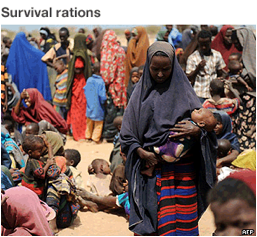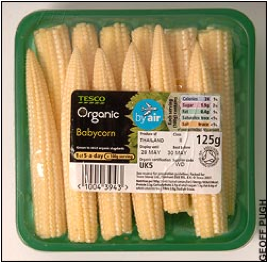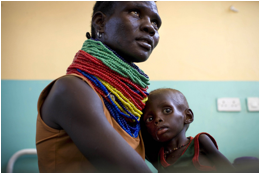In the lifetime of my grandchildren the population of the world will increase from six billion to nine billion. Most of that increase will be in the Developing World.
In our world, the Developed World, there is no shortage of food. In fact, we are so wealthy; we can choose what food we eat — the variety is endless and obesity is a major health problem, especially in children.
We can not only choose what variety of food we eat, we can choose what kind of food we eat — so vegetarians and vegans can purchase a balanced diet free of those items they have chosen not to eat, and meat eaters, carnivores as my daughter calls us, find our choices are almost endless.
As we wander the aisles of the supermarket taking our time making our choices, every three seconds one child dies of starvation on the Horn of Africa.
In the Developed World we willingly pay a premium, sometimes a substantial premium to satisfy our epicurean cravings as we fly the food we must have around the world. But we can afford it; who cares?
And before everyone beats the hell out of the indulgences of western consumerism — the rich West who can afford to fly food round the world — the fresher the better — have a look at this.
 Feral Goats being loaded in Perth Western Australia
Feral Goats being loaded in Perth Western Australia
There has to be some money in the feral goat business, which we are missing out on. Trap wild goats out in the station country, transport them to Perth by road and then ‘fly’ them by 747 to Malaysia for slaughter. Nice business if you can get it, in Malaysia that is. Lends a whole new meaning to ‘Business Class’.
Then we have Organic Food.
Organic food it is claimed is the fastest growing food market in the Developed World.
‘Thai Organic Babycorn to Tesco UK by Air Freight
It is generally accepted that organic farmers produce less volume of food per hectare than non-organic farmers, about half as much. So if we were to all demand organic food we would need twice as much land than we have at present to grow the food we currently grow, and that land isn’t available.
Organic farmers claim to have lower costs because they don’t use the same fertilizers and chemicals as non-organic farmers and their lower yields are compensated for by the higher prices we pay for their produce.
Organic food production also, we are told, produces a smaller carbon footprint. So we are greener if we eat organic produce. If we are green we care more for the world than the others and that, we are told, should make us feel good.
Organic certification is supervised in Australia by an organisation called The National Association for Sustainable Agriculture, Australia (NASAA). Once a farm is approved by NASAA, the produce from that farm may sold anywhere in the world as certified organic food.
Organic producers tell us that our demand for their produce is insatiable. To meet our demands for organic food, together with non-organic food, much of it packaged and frozen, moves around the world by land, sea and air, and in so doing, creates a carbon footprint. The distance of that travel, and the kind of transport used, determines the size of the carbon footprint the movement creates. But we don’t worry about that, do we? ‘Peak Fuel’ is a scare tactic, and diesel in only $1.50 a litre
In Europe and the United States organic food is a continental traveller together with its companion, non-organic food. And we do some silly things in Australia too.
To satisfy our hedonistic demands we can afford to pay for watermelons, which have travelled 3,500 kilometres from the Northern Territory to Albany. Watermelons are 92% water and 6% sugar. They are green though. In Western Australia bananas from Queensland are almost always cheaper than those from Carnarvon.
We moved house two years ago. Our demand for boxes in which to pack our belongings was seemingly insatiable. Outside a local supermarket there was a bin full of boxes — so we raided it to satisfy our needs.
Several boxes that we took and there were many others, were printed ‘Home Country Organics’. A label attached read: Western Mix 10 X 1kg: Production Date 18-Oct-2010: Best Before 18-Oct-2012: Country of Origin: China.
Examination of the ‘Western Mix’ in the supermarket revealed that it did not carry the global symbol certifying it to be ‘organic’. So what does this mean? What’s in a name? Who Cares?
As we chomp on our food, organic or not, and contemplate the questions of origin, description and the carbon footprint of the food we eat, children are still dying on that wretched place called the Horn of Africa, because they don’t have any food.
It’s called starvation — and this is the twenty first century.
Photo: The Economist.






Well done Roger!
Your comments are like a burr under the saddle. Maybe there is not much we can do about these problems just yet, but we have to start by recognising the problem Let’s hope that as with the “good” old days of no-till, this will inspire collective effort.
Roger, I think you should also consider the level of food waste prevalent in Western society. I would not describe the organic/sustainable food movement as hedonistic, it is on the other spectrum of moral choices…..along with the idea of food miles. Some of your assertions of city slickers are sweeping in the extreme. Eat less, waste less, grow your own!
Craig,
I am of the view that flying organic miniature maize from Thailand to the UK could be classified as hedonistic, that is a devotion to pleasure, in this case at any cost. We get the same product here in Australia and it also comes by air.